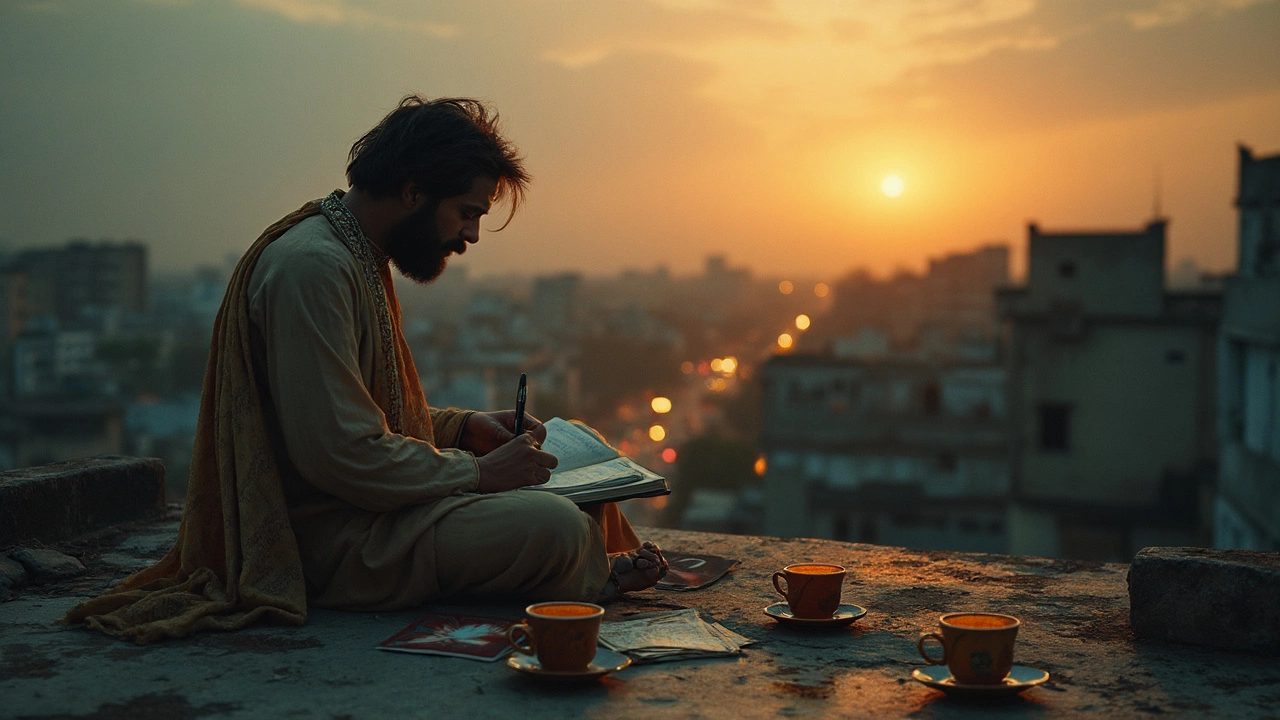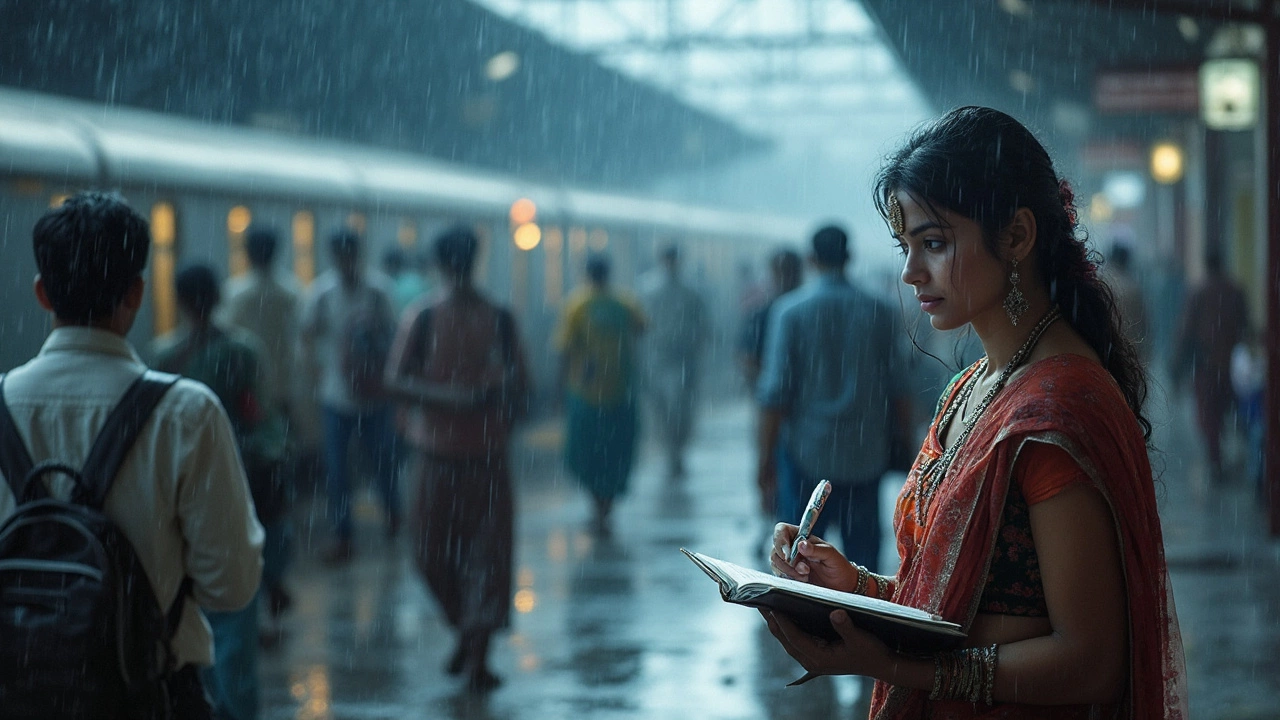Sad Poetry India: What Famous Poet Writes the Saddest Verses?
 Apr, 30 2025
Apr, 30 2025
You ever read something and just feel a punch in your gut? That’s the deal with sad poetry in India. It’s not all just heartbreak and old-school dramas. These poets put real pain, loss, and raw feeling straight on paper—and folks still can’t get enough.
If you think sadness in poetry is just moping, guess again. For many, it’s a way to make sense of things when words usually fail. Some of the most famous Indian poets weren’t just skilled with rhyme—they had their own flavor for heartbreak. Whether it’s longing, regret, or straight-up grief, the top names in Indian poetry have left lines that have lasted for decades (sometimes even centuries).
So, if you’re looking to dig into the who’s who of sad poetry, or you’re just curious about why this genre speaks to so many, you’re in the right spot. Let’s break down how these poems work, which poets stand out, which verses bring out the feels, and, best of all, how you can find poems that’ll really stick with you.
- Why Indian Sad Poetry Hits Different
- The Heavyweights: India’s Most Famous Sad Poets
- Signature Styles and Must-Read Works
- How to Connect With Sad Poetry as a Reader
Why Indian Sad Poetry Hits Different
When people say sad poetry in India is on another level—they’re not joking. There’s a whole cultural backstory. Indian society has always made space for talking about loss and pain, whether it’s family drama, heartbreak, or struggles with life itself. This openness shows up in old-school ghazals, film songs, and even street performances.
Many Indian poets, like Mirza Ghalib and Sahir Ludhianvi, literally built their legacies around sorrow. They didn’t just write for themselves; their work helped others deal with grief and uncertainty. Sahir’s poetry during Partition, for example, voiced the pain of millions who lost homes and families overnight. Lines like “Woh afsana jise anjaam tak lana na ho mumkin” (“The story that can never reach a happy ending”) hit you even if you’re just hearing them decades later.
Another reason this stuff gets under your skin? Indian sad poetry is heavy on imagery and relatable situations. It’s not straight-up tragedies all the time. You get poems about missing someone during festivals, feeling ignored by friends, and facing pressure from society. Think of Gulzar’s modern take—he writes about ordinary heartbreak you’ll find in almost every Indian city or small town.
If you’re wondering why Indian audiences keep coming back for more, here’s a quick breakdown:
- Diversity of languages: Whether it’s Urdu, Hindi, Punjabi, or Bengali, each language brings its own flavor and style. That means more ways for people to express and relate to sadness.
- Crossover with music: Loads of famous sad poems turn up as film lyrics. Legendary songs from Bollywood are often taken straight from poems by legends like Kaifi Azmi or Majrooh Sultanpuri.
- Cultural comfort with emotion: In India, talking openly about feelings—even the hard ones—gets a lot more respect than in some places. People know it’s okay to share sad stories.
- Shared history: From Partition to personal struggle, there’s collective trauma that unites people. Poems remind everyone they’re not alone.
Here’s a quick look at the popularity of sad poetry in India:
| Poet | Estimated Readers (in millions) |
|---|---|
| Mirza Ghalib | 30+ |
| Sahir Ludhianvi | 20+ |
| Gulzar | 25+ |
No matter where you’re from, if you’ve read or heard some Indian sad poetry, you know what it’s like to actually feel seen—sometimes just spelled out in a few lines.
The Heavyweights: India’s Most Famous Sad Poets
If you start digging into sad poetry in India, a few names just keep popping up. Their words hit hard and, honestly, they set the standard for what “feels” means when it comes to verse.
- Mirza Ghalib: No list can skip Ghalib. He lived through his fair share of heartbreak, and it comes through in his Urdu poems. A lot of people still quote his ghazals when they’re feeling down. His lines about lost love and life struggles are straight-up legendary.
- Faiz Ahmed Faiz: Faiz mixed politics, loss, and personal pain. His poetry isn’t just gloomy for the sake of it—he talks about real stuff: exile, separation from loved ones, and heartbreak. His most quoted line, “Hum dekhenge,” proves he knew how to frame pain and hope together.
- Amrita Pritam: Known for her Punjabi poems, Pritam poured her real-life heartbreak into her writing. She wrote openly about unrequited love and tough times after Partition. Her work connects especially with readers who’ve felt alone or lost.
- Gulzar: Even if you don’t read poetry, you’ve probably heard his stuff in films. Gulzar makes everyday sorrows sound relatable, whether it’s through lyrics or short poems. He’s known for capturing the emotion of regret or letting go—often in just a few words.
- Sahir Ludhianvi: Sahir’s poems and film lyrics hit a chord because he didn’t shy away from tough subjects—poverty, lost dreams, and failed love. His sad poetry isn’t old-fashioned either. Even now, people hum his gloomy songs.
Each of these poets has a different take on sadness but the connection is the same—turning tough emotions into words you remember. Their poems get shared, quoted, even used in Bollywood soundtracks. Some of Ghalib’s and Faiz’s lines get thousands of shares a year on social media, showing how famous sad poets from India still strike a chord today.
| Poet | Main Language | Active Years | Signature Theme |
|---|---|---|---|
| Mirza Ghalib | Urdu | 1800s | Loss, love, struggle |
| Faiz Ahmed Faiz | Urdu | 1900s | Exile, heartbreak, hope |
| Amrita Pritam | Punjabi, Hindi | 1900s | Heartbreak, longing |
| Gulzar | Hindi, Urdu | 1960s-now | Everyday sorrow |
| Sahir Ludhianvi | Hindi, Urdu | 1940s-1980s | Lost dreams, pain, society |
Want to go deeper? Search any of these poets online for actual verses. A quick tip: Hindi and Urdu poetry often get posted in Instagram stories or as modern memes. So, even if you aren’t a poetry buff, you’re already seeing their lines somewhere without realizing.

Signature Styles and Must-Read Works
Not all sad poetry hits the same. Each poet brings their own vibe—some spill their heartbreak in simple words, while others wrap pain in layered meanings. Take Mirza Ghalib for example. His Urdu couplets are legendary for mixing deep loss with smart wordplay. One of his lines, “Hazaaron khwahishen aisi ke har khwahish pe dam nikle” (A thousand desires, each so strong they could kill), sums up real-life struggles for so many people. Ghalib’s stuff is short but it stays with you—he fits a whole world of regret into just a couple of lines.
Another big name: Faiz Ahmed Faiz. His poems, like "Mujh Se Pehli Si Mohabbat Mere Mehboob Na Maang," bring up heartbreak, but they also tap into bigger issues like hope and struggle. He didn’t just write about romance, but about the pain of seeing the world around him change.
If you prefer Hindi melancholic poetry, check out Harivansh Rai Bachchan. His book "Madhushala" isn’t just sad—it’s about searching for meaning, disappointment, and picking yourself up again. These poems dig deep into loneliness without ever getting old. And then there’s Sahir Ludhianvi, whose lyrics from old Bollywood films like "Kabhi Kabhi" became anthems for anyone dealing with love gone wrong.
Here’s a cheat sheet for must-read sad poems in India:
- Mirza Ghalib: "Dil-e-Nadaan Tujhe Hua Kya Hai," "Hazaaron Khwahishen Aisi"
- Faiz Ahmed Faiz: "Mujh Se Pehli Si Mohabbat," "Raat Yun Dil Mein Teri"
- Harivansh Rai Bachchan: "Madhushala" (series), "Agneepath"
- Sahir Ludhianvi: "Wo Afsaana Jise Anjam Tak Laana Na Ho Mumkin," "Kabhi Kabhi Mere Dil Mein"
What stands out? Most of these poets didn’t just write for books—they showed up in Bollywood lyrics, public speeches, and even protests. That’s why their words keep popping up at college festivals, weddings, and anywhere people are dealing with heartbreak or tough times. If you’re chasing Indian poets famous for their sad stuff, these names are where you want to start.
To give you an idea of their lasting vibes, check this quick snapshot of how often their works are referenced online and in popular media:
| Poet | Most Famous Sad Poem | Mentions/Year (Est.) |
|---|---|---|
| Mirza Ghalib | Hazaaron Khwahishen Aisi | 250,000+ |
| Faiz Ahmed Faiz | Mujh Se Pehli Si Mohabbat | 190,000+ |
| Harivansh Rai Bachchan | Madhushala | 120,000+ |
| Sahir Ludhianvi | Kabhi Kabhi Mere Dil Mein | 150,000+ |
Bottom line—when you want poetry that really gets how rough it can feel sometimes, these poets will give it to you straight. Dive into their best-known works and you’ll see why they’re still the go-to for sad poetry fans in India.
How to Connect With Sad Poetry as a Reader
Sad poetry isn’t just for people already feeling down. It’s a way to get real about heavy topics, like heartbreak or loss, and feel understood. But if you’re new to sad poetry, it can be tricky to know where to start—or even how to vibe with the poems.
First, give yourself time. Don’t just power through poems one after another. Read one, then sit with it for a bit. Usually, the feelings in these poems come out more when you slow down and just let the words sink in.
- Read Out Loud: This sounds simple, but try reading verses out loud. The rhythm and sound help those emotions hit harder. Famous Indian poets often played with sound for a reason. It’s a more immersive way to connect.
- Pick Famous Names First: If you aren’t sure where to begin, start with classics. Mirza Ghalib and Gulzar, for example, are a good entry point. Their sad poems are famous, not just for the language but for the relatable feelings.
- Join Poetry Groups: There are online forums, WhatsApp groups, and Instagram pages just for sad poetry. Look for hashtags like #SadPoetryIndia. Other readers can point you to their favorite poems or explain meanings you might miss.
- Jot Down What Hits You: Sometimes lines will just jump out and grab you. Save them—write them in a journal or on your phone. You’ll start seeing patterns in what moves you the most.
- Don’t Worry About Language: A lot of sad poetry in India is in Urdu, Hindi, or regional languages. Many translations are available with explanations. Don’t feel left out if you only read in English—it’s about the emotion, not just the language.
Here’s a quick look at which poets and languages are most loved among fans of melancholic poetry in India:
| Poet | Language | Known For |
|---|---|---|
| Mirza Ghalib | Urdu | Heartbreak, love, existential loss |
| Gulzar | Hindi, Urdu | Modern sadness, nostalgia |
| Faiz Ahmed Faiz | Urdu | Personal pain, social grief |
| Sahir Ludhianvi | Hindi, Urdu | Lost love, longing, disillusionment |
Feeling connected to a poem sometimes just means seeing your own story in it. You can even try writing a few lines yourself after reading. The more personal you make the experience, the deeper the connection goes.